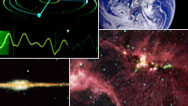SETI: The Search for ET
- Posted 07.23.08
- NOVA scienceNOW
(This program is no longer available for online streaming.) In 1960 an inquisitive astronomer named Frank Drake aimed a radio telescope at a couple of nearby stars and started listening. Nearly 50 years later we're still listening, and SETI—the Search for Extraterrestrial Intelligence—has just expanded to begin the systematic survey of millions of star systems for signs of advanced civilizations. The Allen Telescope will eventually comprise 350 dish antennas, all working in unison to answer the question: Are we alone?
Transcript
SEARCH FOR ET
PBS Airdate: July 23, 2008
NEIL DeGRASSE TYSON: Ever wonder what the chances really are of finding a needle in a haystack? Think they're about as good as finding space aliens?
The search for intelligent life beyond Earth has been going on now for 40 years. Some folks figure, "Hey, if they haven't found it by now, it's probably not there." But as correspondent Andrea Kissick reports, compared to needle hunting, looking for alien life in all the billions of possible places out there is much, much harder.
ANDREA KISSACK: Okay, imagine you're at the beach. In order to figure out if there are fish in the ocean, you dip an empty glass into the water and look inside...no fish in the glass, well, there must be no fish in the ocean. Not too logical, is it? But that's exactly the type of reasoning that's plagued Dr. Jill Tarter for years in her long search for intelligent life in our galaxy.
Astronomers like Tarter began searching for alien intelligence about four decades ago. In that 40 years, they've only managed to search 1,000 star systems—1,000 glasses of water—while an unexplored cosmic ocean lay right in front of them.
JILL TARTER: Forty years needs to be put in the context of how big the universe is, how enormous this cosmic haystack is that we're trying to search through. And, so, we've just begun.
ANDREA KISSACK: Jill knows a little something about SETI, the search for extra-terrestrial intelligence. She's the current director of the Center for SETI Research, in Mountain View, California. Like many SETI scientists, she was drawn into the search by the early work of astronomer Frank Drake.
Drake looked at the makeup of our galaxy and created an equation to determine the likelihood that other intelligent life exists. The equation offered a simple framework for modeling the problem, taking into account things like the fraction of stars with orbiting planets, the percentage of planets that go on to develop intelligent life, and the length of time that an intelligent race lasts. The results were clear: scientifically, the odds are pretty good that we are not alone.
But if you're hunting for E.T., where do you start? What would the sign of a technically sophisticated alien culture look like?
It could look something like this.
These television and radio signals are examples of the electromagnetic waves we've been leaking into space for over 80 years. That means any planet within 80 light years of Earth is receiving them. But TV and radio are only a small part of the electromagnetic spectrum.
Although astronomers use the term "radio waves," they're generally talking about any wavelength longer than a microwave. So the radio frequency spectrum is huge, much wider than the visible light spectrum.
And signals like this are simple to generate, easily pierce dust and atmospheres, and carry well over vast distances. That's why SETI scientists believe alien cultures might be leaking them, just like we are.
In 1979, as a young graduate student, Jill Tarter joined the hunt for these telltale signals.
JILL TARTER: I was so enthralled by the idea that I lived in the first generation, ever, of human beings that could try and answer the "are we alone" question by doing an experiment, rather than just asking the priests and the philosophers what they believed.
ANDREA KISSACK: By the early 1990s, with NASA funding, Tarter was heading up the search at the largest facility in the world, the Arecibo radio telescope, in Puerto Rico. Tarter became the poster child for SETI. Even Hollywood embraced her. Tarter is generally thought to be the inspiration for Ellie Arroway, the character played by Jodi Foster in the classic science fiction movie Contact.
It seemed the golden age of SETI had arrived. Then, in 1993, Congress abruptly shut off all federal SETI funding. But that wasn't the end. Today, nearly 15 years later, something big is happening in this remote valley near Hat Creek, California. SETI's luck may be about to change.
The radio telescope dishes behind me signal the beginning of what many believe will be a SETI renaissance. And if there is to be a breakthrough, the new Allen Telescope Array is the best bet.
The reversal of SETI's fortune has largely been made possible by a $25 million grant from Paul Allen, one of the founders of Microsoft. On October 11, 2007, Allen "pushed the silver button," bringing the first 42 radio dishes on-line. When completed, the Allen Telescope Array will consist of 350 separate dishes. Together they can operate as a single "virtual" dish, over 2,700 feet across, making it one of the largest and most sensitive radio telescopes in the world. It will be the fastest tool ever built to hunt for signals of extra terrestrial intelligence.
Senior SETI astronomer Seth Shostak tells us how this new telescope will work.
SETH SHOSTAK: Well, Andrea, to understand how we're trying to find E.T., you have to understand the technique we're using, and that is to look for signals in what's called the electromagnetic spectrum. That's a lot of Greek, but all it really means for us is the radio dial. We're looking for a signal, somewhere on the radio dial, that they might be broadcasting into space. Let me show you how this works. I'll just turn that on. Okay. Now, you notice that, if I just turn the dial here, you hear static everywhere?
ANDREA KISSACK: Yeah, like white noise.
SETH SHOSTAK: That's just all natural noise. I mean, galaxies and hot gas between the galaxies, and pulsars and quasars, they all make radio noise, and it's everywhere on the dial.
But here...wait a minute...hear that squeal? And then there's the station. All that energy...it's at one spot on the dial. Nature does not make signals that are restricted to one spot on the dial, in general. It just doesn't do that.
ANDREA KISSACK: So that's intelligent life?
SETH SHOSTAK: That's intell...
ANDREA KISSACK: ...depending on your musical taste.
SETH SHOSTAK: It's definitely intelligence.
ANDREA KISSACK: Since the cosmos just don't make narrow, focused signals like this, finding one would be an almost certain sign of an alien culture.
So what is it about this new array that makes it more likely to succeed?
JILL TARTER: The Allen Telescope Array, basically, is all about speed. We can look at more than one star at once. And so, whereas, in the last decade, we looked at about a thousand stars, in the next decade, we'll look at a million.
ANDREA KISSACK: That's because the Allen Array's field of view, the area of sky it sees at one time, is much larger than any other telescope. And it can capture millions of frequencies from multiple star systems, simultaneously. Basically, the Allen Telescope Array is a SETI hot rod with SETI astronomers at the controls, 24/7.
SETH SHOSTAK: So here you can see where the rubber really meets the road for the individual antennas.
ANDREA KISSACK: Wow! That is very Flash Gordon.
SETH SHOSTAK: Indeed it is. In fact, the way this thing works...it's really dead simple. The radio waves from the sky come in, they bounce off that 20-foot diameter reflector, and then they bounce off this somewhat smaller one here, in the front of the antenna, and then they come into this feed. So this is the thing that actually collects the radio waves and turns them into electrical signals, and in fact, down the pedestal, under the ground and back to the control room.
ANDREA KISSACK: So a huge swath of the universe comes right into this room.
SETH SHOSTAK: Yeah, it does, actually. The antennas send everything they collect from the cosmos into this room. It comes in right back here. So all those data come in here, and then we put it together.
ANDREA KISSACK: So how is this different than the SETI of old?
SETH SHOSTAK: Well, the fundamental difference here is simply the amount of data you can handle, and that's just the march of technology. The first SETI experiment, back in 1960, one channel of the radio. Here we've got 100 million channels coming in.
ANDREA KISSACK: The sheer scale of the search is almost impossible to imagine. Remember, in our galaxy alone, there are about 300 billion other suns, many with orbiting planets. And beyond that, lie a hundred billion other galaxies just like our own.
Even in its current configuration, the array's virtual dish gathers nine times more information than present-day processor technology can decode. That means 90 percent of what the telescope observes is simply thrown away, at least for now. So for the next decade or two, the technology in this little room will be playing catch-up with the dishes outside.
SETH SHOSTAK: All this stuff will be replaced, in another five years, by yet faster machines, which allow us to look at more star systems, more channels, in other words: to speed up the SETI search.
ANDREA KISSACK: And as that search accelerates, Tarter and other SETI scientists are thinking about the consequences of success.
JILL TARTER: If we detect a signal, we'll do everything that we can at this site to make sure that it isn't our own technology that's fooling us or that it isn't a deliberate hoax. If we get an independent confirmation, then we will, in fact, tell the world. Because a signal isn't being sent to the Allen Telescope Array, it's being sent to the planet Earth, and the planet Earth deserves to know about it.
ANDREA KISSACK: For Jill Tarter, it's a scenario she's imagined for almost 30 years. Detecting even the accidental noise, the "dial tone" of an alien culture, would finally answer one of the most ancient questions of all.
JILL TARTER: Are we alone? Humans have been asking it forever.
The probability of success is difficult to estimate, but if we never search, the chance of success is zero.
Credits
The Search for ET
- Edited by
- Stephanie Challberg
- Produced and Directed by
- Josh Rosen
NOVA scienceNOW
- Executive Producer
- Samuel Fine
- Executive Editor
- Neil deGrasse Tyson
- Senior Series Producer
- Vincent Liota
- Supervising Producers
- Stephen
Sweigart
Joey David - Editorial Producer
- Julia Cort
- Development Producer
- Vinita Mehta
- Senior Editor
- David Chmura
- Online Editor
- Laura Raimondo
- Series Production Assistant
- Fran Laks
- Assistant Editors
- Susan Perla
Tung-Jen (Sunny) Chiang - Compositors
- Brian Edgerton
Yunsik Noh - Music
- Rob Morsberger
- NOVA scienceNOW series animation
- Edgeworx
- Associate Producers
- Melanie
Cunningham
Heeth Grantham
Joan Johnson
Molly Longstreth
Anthony Manupelli
Corey Norman - Camera
- John Baynard
James Callanan
Brian Dowley
Mike Elwell
Tom Fahey
Sean Glenn - Sound Recordists
- Brad Berghom
Clint Bramesco
John Cameron
Tom Eichler
Bill Stefanacci
Dick Williams - Sound Mix
- David Chmura
- Animation
- Eyeball
Carlo Flores
Anthony Kraus, Noisy Neighbor Productions
Zaldy Serrano - Production Assistants
-
Jared Flynn
Elizabeth Stachow
Robin Wiesner - For Lone Wolf Documentary Group
- Executive Producer
- Kirk Wolfinger
- Production Manager
- Donna Huttemann
- For Public Broadcasting for Northern California, KQED
- Executive producer
- Sue Ellen McCann
- Business Manager
- Sandy Schonning
- Archival Material
- California High Speed Rail Authority
Corbis
Mary Evans / Photo Researchers, Inc.
Ship and submersible footage courtesy of Harbor Branch Oceanographic Institute
NASA / STScI
Newlands and Company, Inc.
Orion Treasury Project Team
Orwell Astronomical Society (OASI)
SETI Institute
University of Alabama at Birmingham Department of Pathology PEIR Digital Library
U.S. National Library of Medicine
Edie Widder
Nikica Zaninovic, Richard Bodine, Roger Gosden, Zev Rosenwaks, Lucinda Veeck Gosden at the Center for Reproductive Medicine and Infertility
Embryology Laboratory, Weill Cornell Medical College, New York. - Special Thanks
-
American Museum of Natural History
Beth Israel Deaconess Medical Center
Harbor Branch Oceanographic Institute
Christy Herren
Tom Kilsdonk, SETI Institute
Kevin Langton
John Lewis
Larry Madin
Illustrator Janeen Mason
Michael Nank
Chris Neller, SETI Institute
The ORCA Team
Karen Randall, SETI Institute
Brad Seibel
Yankee - Neil deGrasse Tyson
- is director of the Hayden Planetarium in the Rose Center for Earth and Space at the American Museum of Natural History.
- NOVA scienceNOW Consortium Stations
- Nebraska
Educational Telecommunications, NET
Public Broadcasting for Northern California, KQED
Twin Cities Public Television, TPT
Wisconsin Public Television, WPT - NOVA Series Graphics
- yU + co.
- NOVA Theme Music
- Walter Werzowa
John Luker
Musikvergnuegen, Inc. - Additional NOVA Theme Music
- Ray Loring
Rob Morsberger - Post Production Online Editor
- Spencer Gentry
- Closed Captioning
- The Caption Center
- Publicity
- Carole McFall
Eileen Campion
Lindsay de la Rigaudiere
Victoria Louie
Kate Becker - Senior researcher
- Gaia Remerowski
- Production Coordinator
- Linda Callahan
- Paralegals
-
Raphael Nemes
Sarah Erlandson - Talent Relations
- Scott Kardel, Esq.
Janice Flood - Legal Counsel
- Susan Rosen
- Post Production Assistant
- Darcy Forlenza
- Associate Producer, Post Production
- Patrick Carey
- Post Production Supervisor
- Regina O'Toole
- Post Production Editors
-
Rebecca Nieto
Alex Kreuter - Post Production Manager
- Nathan Gunner
- Compliance Manager
- Linzy Emery
- Development Producer
- Pamela Rosenstein
- Business Manager
- Joseph P. Tracy
- Senior Producer and Project Director
- Lisa Mirowitz
- Coordinating Producer
- Laurie Cahalane
- Senior Science Editor
- Evan Hadingham
- Senior Series Producer
- Melanie Wallace
- Managing Director
- Alan Ritsko
- Senior Executive Producer
- Paula S. Apsell
This material is based upon work supported by the National Science Foundation under Grant No. 0638931. Any opinions, findings, and conclusions or recommendations expressed in this material are those of the author(s) and do not necessarily reflect the views of the National Science Foundation
NOVA scienceNOW is a trademark of the WGBH Educational Foundation
NOVA scienceNOW is produced for WGBH/Boston by NOVA
© 2008 WGBH Educational Foundation
All rights reserved
- Image credit: (satellite dish) Courtesy Seth Shostack
Participants
- Andrea Kissack
- Correspondent
- Seth Shostak
- SETI Institute
- Jill Tarter
- SETI Institute
Related Links
-

Aliens in the Milky Way?
Do you think alien civilizations exist beyond Earth? Explore the arguments, then cast your vote.
-

The Search for ET: Expert Q&A
Seth Shostak, Senior Astronomer at the SETI Institute and perhaps the funniest man in astrobiology, answers questions.
-

The Drake Equation
Try your hand at calculating how many intelligent, communicating civilizations might be in our galaxy.
-

Hunt for Alien Earths
Astronomers may be on the brink of finding Earth-like planets beyond our solar system.
-

Detecting Life Beyond Earth
In this video and quiz, see how scientists sniff out signs of life on distant planets, then try it yourself.
-

Eavesdropping on ET
SETI astronomer Seth Shostak holds out hope that we will one day receive a signal from afar.



